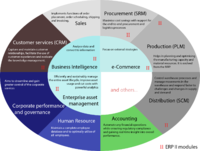
Photo from wikipedia
Background This study evaluated the impact of atherosclerotic cardiovascular disease (ASCVD) on healthcare resource utilization and costs in patients with type 2 diabetes mellitus (T2DM). Methods This study was a… Click to show full abstract
Background This study evaluated the impact of atherosclerotic cardiovascular disease (ASCVD) on healthcare resource utilization and costs in patients with type 2 diabetes mellitus (T2DM). Methods This study was a retrospective, cross-sectional study using US claims data. Adult patients with T2DM were stratified by presence or absence of ASCVD and compared regarding annual (2015) healthcare resource utilization and associated costs. Subgroup analyses were conducted for three age groups (18–44, 45–64, and ≥ 65 years). Results Among 1,202,596 eligible patients with T2DM, 45.2% had documented ASCVD. The proportions of patients with inpatient and ER-based resource utilization during 2015 were three-to-four times greater in the ASCVD cohort as compared to the non-ASCVD cohort for the categories of inpatient visits (15.6% vs 4.4% of patients), outpatient ER visits (18.4% vs 5.2% of patients), and inpatient ER visits (4.3% vs 0.9% of patients). Outpatient utilization also was higher among patients with ASCVD as compared to those without ASCVD (mean number of annual office visits per patient, 9.1 vs 5.6), and more than twice as many patients with ASCVD had ≥ 9 office visits (43.5% vs 19.8%). Average per-patient total healthcare cost was $22,977 for ASCVD vs $9735 for non-ASCVD, with medical costs primarily driving the difference ($17,849 vs $6079); the difference in pharmacy costs was smaller ($5128 vs $3656). In the 18–44, 45–64, and ≥ 65 age subgroups respectively, total annual healthcare costs were 143, 127, and 114% higher in ASCVD vs non-ASCVD patients. Conclusions These findings indicate significantly higher healthcare resource utilization and associated costs in patients having T2DM with ASCVD compared to T2DM without ASCVD.
Journal Title: Clinical Diabetes and Endocrinology
Year Published: 2020
Link to full text (if available)
Share on Social Media: Sign Up to like & get
recommendations!